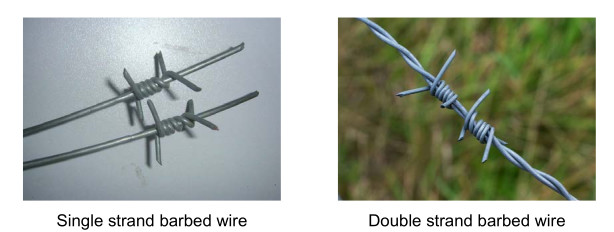
Barbed Wire: Types, Specifications and More
barbed wire is a fence product that is used around the world. It’s used on agricultural fences, to keep animals in (or out), on top of mesh fences for added security, and with brackets for wall top security. It’s even used on taut wire fences, as part of a high security perimeter fence system.
If you’re not a “fence person” you might think that barbed wire is all the same, however, that’s not true. Here’s what you need to know about barbed wire, so you can make the right choices.
How Is barbed wire Sold?
Barbed wire is sold in spools, which is a roll of wire with a central hole or core. These can be used on spindles for easier rolling out.
In different parts of the world, barbed wire spools are measured differently. So, in some places, a spool of barbed wire might be 35kgs, while in others, you might buy it in spools of 1320 linear feet. No matter where you are though, spools or rolls of barbed wire are roughly the same size.
If you have to fence a large area, you can also buy barbed wire by the pallet, and like with most bulk buys, the more you buy, the better the discount you can usually negotiate.
How to Read Barbed Wire Descriptions and Specifications
As we’ve already mentioned, there’s no one size fits all barbed wire. There are several differences between different kinds of barbed wire. Here are a few things that might change, based on the type of barbed wire you buy, and where you get it!
Barbed Wire Strands

The first difference between types of barbed wire is the number of strands. This refers to the continuous wire that forms the “core” of the barbed wire. There are single strand and double strand varieties.
Of course, single strand barbed wire is a little cheaper because there’s less steel in it, but it’s also not as strong, so if you need a more robust product, double strand might be the right option.
Barb Type
Barbed wire also comes in single and double barb varieties. Single barb has two barbs per twist, while double barb has four barbs per twist.
Steel Type
There are different types of steel that are used to manufacture barbed wire. Sometimes, it’s the same type of wire that is used for mesh and other applications, but there are also high tensile barbed wires on the market. Again, choose the product you use based on your site’s requirement.
Other Metals
Barbed wire is sometimes also available in fence grade aluminum alloys and stainless steel, however, they are usually a lot harder to source than galvanized barbed wire and galvanized and PVC coated barbed wire.
Number of Barbs
Another thing that you might notice when reading a barbed wire specification is that the number of barbs is specified. This is a number that refers to the number of wire “spikes” on each barb.
Many barbed wire specifications also stipulate how frequent the barbs are along the core wire, which could be 4 inches or about 100mm, or 6 inches, which is about 150mm. The more barbs you have, and the closer they are to each other, the more secure the barbed wire will be.
Finish
Most barbed wire that is used for agriculture or security is made from galvanized steel wire. However, there are also plastic coated barbed wire options out there. These usually match the color of the fence they will be used on.
Must Have Barbed Wire Tools
If you are going to install barbed wire on your fence, no matter what kind of fence you are building, you’re going to need some tools and equipment. Here are some commonly used tools and equipment that will help you to get the job done right – and safely!
Barbed Wire Tools
Working with barbed wire is a little different to working with smooth wire and other fence materials and products. There are a few tools and supplies that will help to make the process a little easier and give you a better result.
Barbed Wire Fence PliersThese barbed wire fence pliers are a specialized multi tool that includes a wire cutter, a hook to remove barbed stables and an integrated hammer. There are other kinds of fence pliers out there, but if you're looking for one that combines various tools into one easy to carry unit, this is a great choice. |
||
Wire Grippers
There are various wire grippers on the market, but they all do mostly the same thing - allow you to grip wire and twist it without hurting your hands. |
||
A Fence Strainer
There are several types of fence strainers out there too, and they're a great addition to your barbed wire install toolbox. These strainers usually combine a ratchet of some kind with a chain and hooks, so you can grip wire or barbed wire and pull it much tighter than you can by hand. |
||
Barbed Staples
Barbed staples are the best way to secure barbed wire to wooden posts. There are different lengths available, and there are single and double barbed options. |
||
Fencing Gloves
If you're going to work with any fence materials and tools - but especially sharp materials like barbed wire and razor wire, you want to have a good pair of leather fencing gloves like these ones. They prevent cuts and scratches, and also help to prevent blisters if you're not used to using fencing pliers and tools! |
Barbed Wire Fence Installers
Most fence companies that install chain link fence or mesh fence will add barbed wire to an overhang extension above the fence. However, fully barbed wire fences like those that are installed to keep cattle in are not usually something that commercial or residential fence contractors will do. So if you want to hire a contractor to do that kind of barbed wire fencing, look for one who specializes in agricultural fence.


